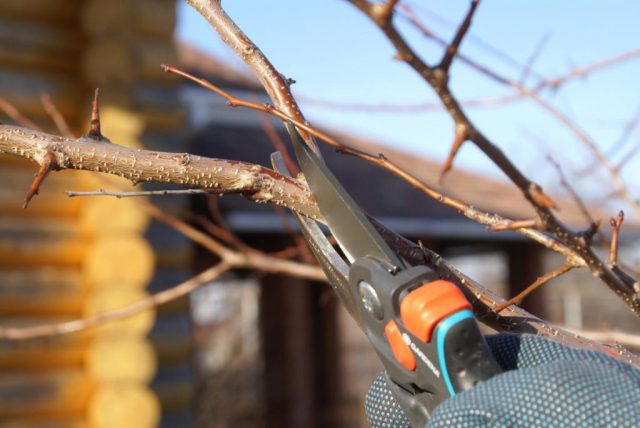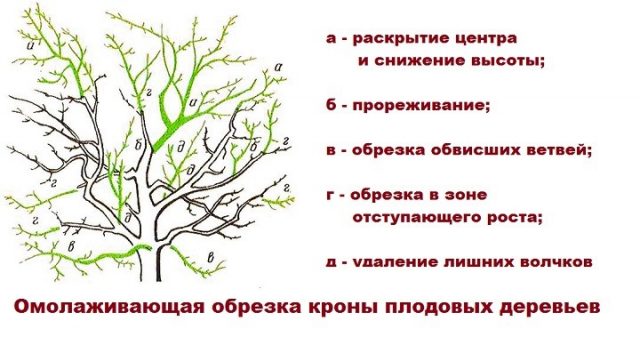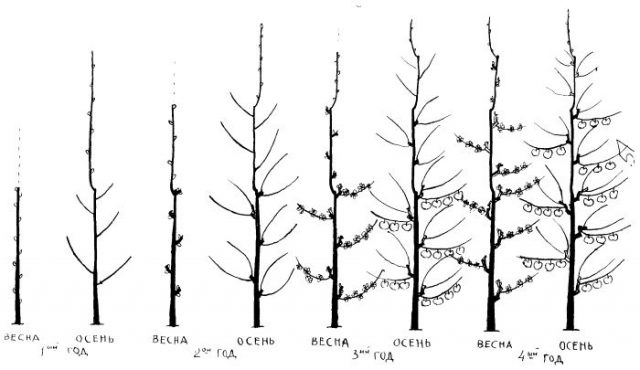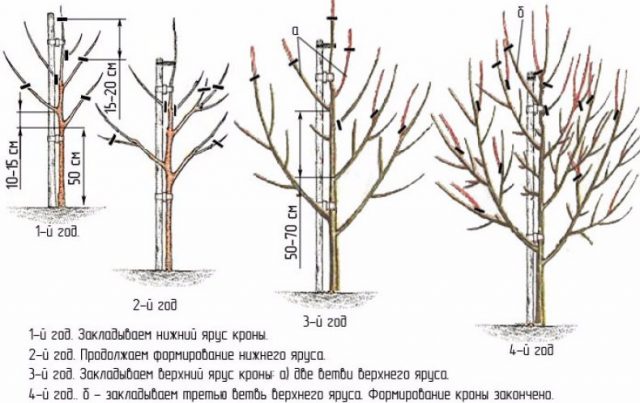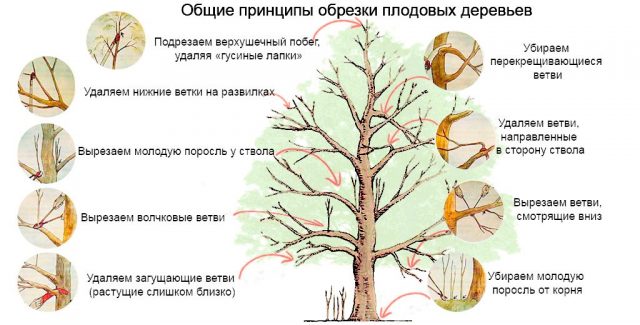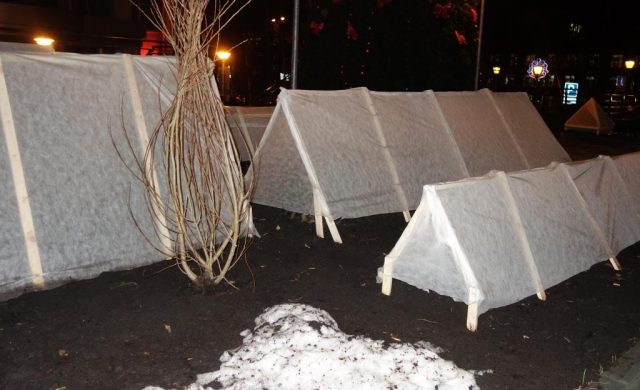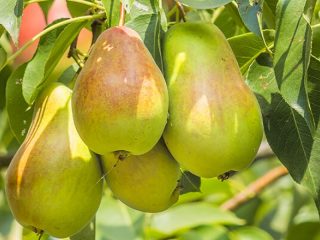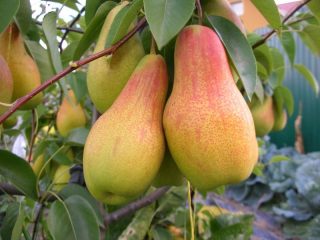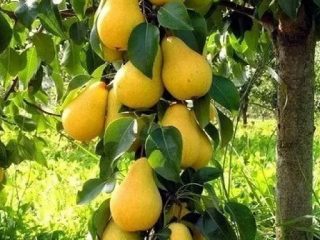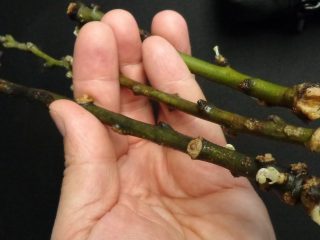Content
Among the many types of fruit trees grown on the territory of Russia, the pear takes one of the first places. Many gardeners love it for its variety of varieties, high yield and unpretentiousness. However, in order to fully reveal the full potential inherent in this tree, it is necessary to carry out certain care measures. These include the autumn pruning of pears.
Is it possible to prune a pear in the fall
Many gardeners avoid pruning in the fall, arguing that this procedure reduces the winter hardiness of trees. This is indeed the case. Therefore, in the fall, young pears are not pruned, as well as varieties with weak winter hardiness. Otherwise, the spring and autumn pruning is identical, both are carried out during the period while the tree is dormant.
It is more expedient in autumn prune mature trees, since there is no danger of missing the deadline, and the whole procedure can be carried out without haste. Weather conditions at this time, as a rule, are much better than spring ones, at this time there is no dirt underfoot, and the air temperature is more comfortable.
When and in what month to cut a pear in the fall
Pear pruning is done during the period when it is already in hibernation. The fact that the tree has entered the resting phase is indicated by the end of the leaf fall. It is at this time, when the crop is harvested, and it is still quite a long time before frost, and you need to prune. In different regions, this period occurs at different times. In the central part of Russia, for example, in the Moscow region, autumn pruning of pears is carried out at the beginning of September, in more southern regions this period is September or even the beginning of October.
How to prune a pear in the fall
Before carrying out the autumn pruning of pears, it is necessary to prepare gardening tools. All cutting edges must be sharpened because the cleaner and smoother the cut, the faster it heals. To prune a pear you will need:
- secateurs;
- garden hacksaw;
- lopper.
All of them must be disinfected before work. For this, you can use a solution of a fungicide, for example, copper sulfate, or any alcohol-containing liquid.
In addition, you need to stock up on garden varieties. They cover all places of cuts with a diameter of more than 2-2.5 cm. It is advisable to use a garden pitch on a natural basis, made, for example, from fir resin. It is undesirable to use putties based on petroleum products. And you can also cover the sections with oil paint on drying oil, in extreme cases - with a mixture of mullein and clay.
Autumn pruning involves two main operations:
- Thinning.
- Shortening.
Thinning the crown of a pear is the main operation that is carried out in the autumn. This is done to brighten the interior of the tree, as well as for sanitary purposes, removing dried, diseased, broken and damaged branches. Shortening promotes the growth of lateral shoots, and is also carried out in order to limit growth and maintain the existing crown shape.
How to rejuvenate an old pear in autumn
An adult pear is a powerful, spreading tree of rather large height. Shoot formation in it is much more intense than in the apple tree. If you skip 1-2 seasons, the crown of the tree will be very thickened. Therefore, it is very important to prune pears regularly. At the same time, it is important to preserve the formed fruit tiers in accordance with the principle of subordination, that is, to prevent the branches of the lower tier from growing higher than the higher one.
An approximate scheme for pruning an old pear in the fall is shown in the figure below.
The crown is thinned out using a pruner and a hacksaw. Broken, diseased, improperly growing and thickening branches are removed. Shoots with a thickness of 3 cm or more are removed with a hacksaw, the largest ones are pre-sawed from below, so as not to cause scoring of the bark when breaking off. At the same time, the annual growth is shortened by 1/3 or ¼, depending on the strength of growth, using a pruner. In this case, the direction of growth of the bud, on which the shoot is pruned, changes from year to year so that the branch grows in a zigzag manner.
It should be remembered that the pear will spend part of the nutrients stored for the winter on the healing of the resulting wounds. In order not to greatly weaken the tree before the onset of frost, significant pruning must be carried out in parts. Large branches are first shortened over several seasons and then removed completely.
How to properly prune a two-year-old pear in the fall
In the first autumn, the pear seedling is not cut, this can weaken it very much. In two-year-old pears autumn pruning is reduced to shortening by a quarter of the annual growth, and also at this time the central conductor is cut so that it is 0.25 m higher than the level of the upper tier of skeletal branches.
How to properly prune a three-year-old pear in the fall
The pruning of pears in the third year of life in the fall is carried out according to the same scheme as in the second year. Together with the shortening of the annual growth, the inner space of the crown is cleared, branches growing inward, downward, crossing each other, tops and competing shoots are removed. By the third year, the first fruiting layer should finally be formed.
Pruning a columnar pear in the fall
Autumn pruning of a columnar pear is usually not difficult and comes down to maintaining the damage in its existing shape and size, as well as removing dry, broken and diseased branches. Due to the high ability of the pear to shoot out, it is necessary to pay special attention to the branches growing deeper into the crown, and remove them in a timely manner. If these shoots are not touched, the inner space of the pear will very soon turn into a ball of stems tightly intertwined with each other. This will disrupt air exchange, reduce yields, and can also lead to diseases.
How to shape a pear in the fall
Pear formation is carried out from the moment of planting until the age of 4-5 years. As a rule, this is a sparse-tiered method, in which two fruit tiers are formed. By the 5th year of life, the active growth of shoots slows down, and subsequent pruning is carried out only in order to maintain the crown in the required dimensions.
Pruning pears in autumn for beginners in pictures
The figure below shows the process of forming a sparse-tiered crown of a pear tree by years of life.
When pruning a pear in autumn, certain rules must be followed. Removing or pruning a shoot is done in one of three ways:
- Cutting "to the ring"... It is a complete removal of the shoot at the base of the annular bead in the place where it begins to grow. The correct removal of the shoot "on the ring" and typical mistakes when performing this procedure are shown in the figure below.
- Pruning for a promising bud. It is carried out to regulate or change the direction of growth of the shoot.A cut on a promising kidney is carried out parallel to the axis of its growth, while the cut should start above the level of the kidney and end just above its top point. Pruning a shoot for a bud is shown in the figure below.
- Pruning "for a promising escape"... It is used to translate the direction of growth to a shoot growing in the desired direction. It is carried out using the same technology as the pruning for the kidney.
The basic principles for thinning and lightening the inner space of the crown are presented in the following figure.
Caring for the tree after pruning
Pruning pears in autumn weakens the tree, making it more vulnerable to frost and adverse weather conditions. It should not be carried out if less than a month remains before the onset of cold weather, since in this case there is a possibility that the weakened plant simply will not survive the winter. It is also not worth cutting off a significant part of the crown, because wound healing takes not only time, it is also the consumption of nutrients stored by the tree for wintering.
After pruning, all sections must be treated with garden varnish. The cut branches must be collected and burned. This is especially true for old trees, as well as for pears, on which the appearance of diseases or pests was noted during the season.
How to prepare a pear for winter
The pear has good frost resistance, but some of its varieties, as well as young trees, need additional protection measures in winter. First of all, these include whitewashing of the trunk and lower skeletal branches. This is an effective preventive measure that will help avoid sunburn and frost damage. Whitewashing serves as good protection against rodents and hares.
As a whitening composition, you can use a solution of slaked lime. For resistance to atmospheric moisture, it is recommended to add PVA glue to the composition. Trees can be whitewashed with acrylic water-dispersion paint. However, it should be remembered that whitewashing impairs the air exchange of the bark of the tree, therefore, seedlings and young trees should be whitewashed only with a "breathing" compound.
Trunk circles must be cleaned of fallen leaves and fruit rot; many insect pests and their larvae hibernate in this environment. After cleaning, the root zone is dug up, spilled with water and covered with a layer of peat or humus mulch. It is advisable to add a little potash and phosphorus fertilizers, this will increase winter hardiness.
Young pear seedlings, which do not have good winter hardiness, must be covered. This is especially true in the northern regions. Any breathable material can be used for this, for example, agrofibre or burlap.
An additional insulating element can be spruce branches, which are tied to the trunk.
Preparing pears for winter in the suburbs
Winters in the Moscow region are not very harsh, especially in recent years. However, changeable weather can bring surprises, and this should be prepared in advance. All measures to prepare pears for winter in the middle lane must be completed in full. Young trees must be covered. This can be done, for example, with conventional pipe insulation.
It will protect the trees well from the cold wind and at the same time will not impede the access of air to the trunk. You can restrict access to hares by installing a metal mesh fence around the trunk.
Preparing pears for winter in Siberia
The early arrival of winter makes the autumn pruning of pears in Siberia impractical. The harsh winter is an ordeal for the fruit trees grown in this region. Therefore, you should not additionally weaken them in the pre-winter period. All young trees must be insulated before wintering. As a rule, a temporary shelter is built around the seedlings, which is a wooden frame covered with non-woven fabric or parchment.
You can insulate the seedlings using white polypropylene bags, in which there is no bottom.Such a bag is put on the tree from above, and the inner space is stuffed with straw or shavings.
Spruce branches can also be used as an additional heat-insulating layer.
Gardeners' recommendations
Experienced gardeners, when pruning pears in the fall, recommend that beginners adhere to the following rules:
- Careful preparation is the key to success. It is necessary to inspect the trees in advance and plan the sequence of work.
- There are no exact dates for pruning. You always need to be guided by the weather and climate in the region.
- A good tool is the foundation of a healthy garden. A high-quality sharp instrument inflicts much less damage, which heals faster.
- Safety comes first. When working with the tool, all safety rules must be observed, especially when working with the upper tier of the crown.
- Compliance with the principle of subordination. The branches of the lower tier should not be higher than the branches of the higher one.
- It is always better to prune one thick branch rather than several smaller ones.
- All work must be started from the upper tier of the crown.
- Trimming tops on a pear can be done not only in autumn, but throughout the season.
Conclusion
Autumn pruning of pears is a rather difficult procedure, especially if it is done for the first time. Therefore, it is advisable to take the help of an experienced mentor. And also it must be remembered that a violation of the timing of pruning is more likely to bring harm to the tree than good. Therefore, there is no need to rush and strive to make it at all costs. If the deadlines are missed, it is better to properly prepare and hold the event in the spring.
